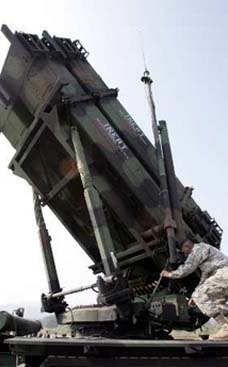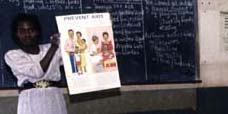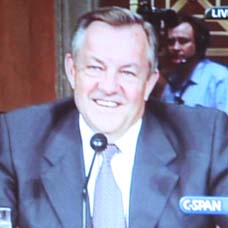2006.09.20: September 20, 2006: Headlines: COS - India: Aikido: Austin American-Statesman: India RPCV Josef Birdsong practices Aikido
Peace Corps Online:
Directory:
India:
Peace Corps India:
The Peace Corps in India:
2006.09.20: September 20, 2006: Headlines: COS - India: Aikido: Austin American-Statesman: India RPCV Josef Birdsong practices Aikido
India RPCV Josef Birdsong practices Aikido
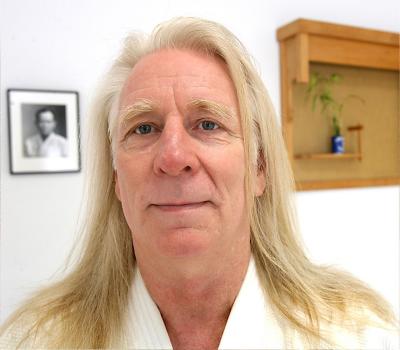
"I'm a nonviolent kind of guy," Birdsong said, explaining his initial attraction to aikido. "I'd been to India for the Peace Corps, and I was practicing yoga at the time . . . Then I met my aikido teacher, Akira Takei. As they say, the teacher arrives when the student is ready."
India RPCV Josef Birdsong practices Aikido
Everybody was (insert martial art here) fighting
In Austin, there's no shortage of places to get your kicks
By Shermakaye Bass
Wednesday, September 20, 2006
Caption: 'The key to aikido lies in the balancing of internal and external energies,' says Josef Birdsong, who launched the aikido program at Austin Community College in 1986.
Remember the 1970s "golden era" of martial arts in America, when everybody was kung fu fighting and Chuck Norris was an upstart, albeit one with a mean roundhouse kick?
If you're of a certain age, grasshopper, you'll recall those freeze-frame, flashback days, when David Carradine and Bruce Lee unfurled their heroic maneuvers across TV and cinema screens.
[Excerpt]
Aikido
Josef Birdsong, Aikido of Austin
In his crisp black hakama (skirt) and silver ponytail, Josef Birdsong has the aura of a Japanese sage. The 61-year-old, who is actually Irish and American Indian, possesses the serenity of someone who might have retreated to a high mountain hermitage at some point in his life. Birdsong oozes aikido — the Japanese term for "the way of unity with the life force."
As you'd expect from such a description, this martial art is a study in harmony, a nonviolent and deflective style practiced by the thoughtful "warrior," mostly in self-defense. "The key to aikido," said Birdsong, a Sacramento native and former Peace Corps volunteer, "lies in the balancing of internal and external energies," tapping into one's own core nature while using the force of the attacker to neutralize him.
For these reasons, some argue that aikido is not a "true" martial art — not a warring art, but a healing one. Birdsong would beg to differ. A fifth-degree black belt who has been teaching aikido for half his life (he launched the aikido program at Austin Community College in 1986, after teaching a similar program at the University of Illinois), Birdsong said that by using rolls, blocks, joint-locks and other nonaggressive moves, aikido's mission is to stop violence, not further it.
"Fighting is not the point," he said.
The system incorporates traditional Japanese fighting styles such as judo and jujitsu, but it was created by a self-proclaimed peace-seeker in the early 1900s, Morihei Ueshiba. The great-grandson of a samurai warrior, Ueshiba trained in the classic arts before developing his meditative hybrid and opening a dojo, or place of learning, in Tokyo before World War II. The structure remains, and today houses the World Aikido Headquarters. Birdsong has visited three times. His own dojo, Aikido of Austin, has been around in some form since 1985, when his organization was accepted into the U.S. Aikido Federation. The current studio is airy, welcoming in its quietude.
"I'm a nonviolent kind of guy," Birdsong said, explaining his initial attraction to aikido. "I'd been to India for the Peace Corps, and I was practicing yoga at the time . . . Then I met my aikido teacher, Akira Takei. As they say, the teacher arrives when the student is ready." Later, Birdsong received a master's degree in physical education, but instead of taking a more conventional teaching path, he followed his aikido calling. In 30-odd years of instructing, he estimates he's taught more than 10,000 students.
(Aikido of Austin. 5501 N. Lamar Blvd., No. C11. 323-0123, www.austinaikido.org. Monthly fees: $90 to $100.)
Links to Related Topics (Tags):
Headlines: September, 2006; COS - India; Texas
When this story was posted in November 2006, this was on the front page of PCOL:





Peace Corps Online The Independent News Forum serving Returned Peace Corps Volunteers
 | Harris Wofford to speak at "PC History" series
Senator Harris Wofford will be the speaker at the 4th Annual "Peace Corps History" series on November 16 sponsored by the University of Maryland at Baltimore County (UMBC) and the Maryland Returned Volunteers. Previous speakers in the series have included Jack Vaughn (Second Director of the Peace Corps), Scott Stossel (Biographer of Sargent Shriver), and C. Payne Lucas (President Emeritus of Africare). Details on the time and location of the event are available here. |
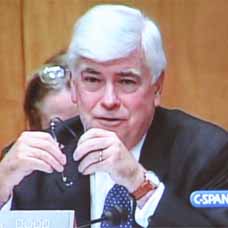 | Chris Dodd's Vision for the Peace Corps
Senator Chris Dodd (RPCV Dominican Republic) spoke at the ceremony for this year's Shriver Award and elaborated on issues he raised at Ron Tschetter's hearings. Dodd plans to introduce legislation that may include: setting aside a portion of Peace Corps' budget as seed money for demonstration projects and third goal activities (after adjusting the annual budget upward to accommodate the added expense), more volunteer input into Peace Corps operations, removing medical, healthcare and tax impediments that discourage older volunteers, providing more transparency in the medical screening and appeals process, a more comprehensive health safety net for recently-returned volunteers, and authorizing volunteers to accept, under certain circumstances, private donations to support their development projects. He plans to circulate draft legislation for review to members of the Peace Corps community and welcomes RPCV comments. |
 | He served with honor
One year ago, Staff Sgt. Robert J. Paul (RPCV Kenya) carried on an ongoing dialog on this website on the military and the peace corps and his role as a member of a Civil Affairs Team in Iraq and Afghanistan. We have just received a report that Sargeant Paul has been killed by a car bomb in Kabul. Words cannot express our feeling of loss for this tremendous injury to the entire RPCV community. Most of us didn't know him personally but we knew him from his words. Our thoughts go out to his family and friends. He was one of ours and he served with honor. |
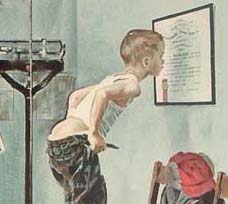 | Peace Corps' Screening and Medical Clearance
The purpose of Peace Corps' screening and medical clearance process is to ensure safe accommodation for applicants and minimize undue risk exposure for volunteers to allow PCVS to complete their service without compromising their entry health status. To further these goals, PCOL has obtained a copy of the Peace Corps Screening Guidelines Manual through the Freedom of Information Act (FOIA) and has posted it in the "Peace Corps Library." Applicants and Medical Professionals (especially those who have already served as volunteers) are urged to review the guidelines and leave their comments and suggestions. Then read the story of one RPCV's journey through medical screening and his suggestions for changes to the process. |
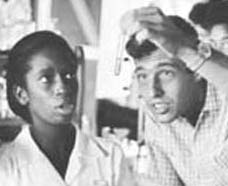 | The Peace Corps is "fashionable" again
The LA Times says that "the Peace Corps is booming again and "It's hard to know exactly what's behind the resurgence." PCOL Comment: Since the founding of the Peace Corps 45 years ago, Americans have answered Kennedy's call: "Ask not what your country can do for you--ask what you can do for your country. My fellow citizens of the world: ask not what America will do for you, but what together we can do for the freedom of man." Over 182,000 have served. Another 200,000 have applied and been unable to serve because of lack of Congressional funding. The Peace Corps has never gone out of fashion. It's Congress that hasn't been keeping pace. |
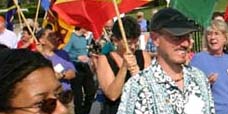 | PCOL readership increases 100%
Monthly readership on "Peace Corps Online" has increased in the past twelve months to 350,000 visitors - over eleven thousand every day - a 100% increase since this time last year. Thanks again, RPCVs and Friends of the Peace Corps, for making PCOL your source of information for the Peace Corps community. And thanks for supporting the Peace Corps Library and History of the Peace Corps. Stay tuned, the best is yet to come. |
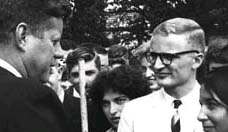 | History of the Peace Corps
PCOL is proud to announce that Phase One of the "History of the Peace Corps" is now available online. This installment includes over 5,000 pages of primary source documents from the archives of the Peace Corps including every issue of "Peace Corps News," "Peace Corps Times," "Peace Corps Volunteer," "Action Update," and every annual report of the Peace Corps to Congress since 1961. "Ask Not" is an ongoing project. Read how you can help. |
Read the stories and leave your comments.

Some postings on Peace Corps Online are provided to the individual members of this group without permission of the copyright owner for the non-profit purposes of criticism, comment, education, scholarship, and research under the "Fair Use" provisions of U.S. Government copyright laws and they may not be distributed further without permission of the copyright owner. Peace Corps Online does not vouch for the accuracy of the content of the postings, which is the sole responsibility of the copyright holder.
Story Source: Austin American-Statesman
This story has been posted in the following forums: : Headlines; COS - India; Aikido
PCOL34518
03








